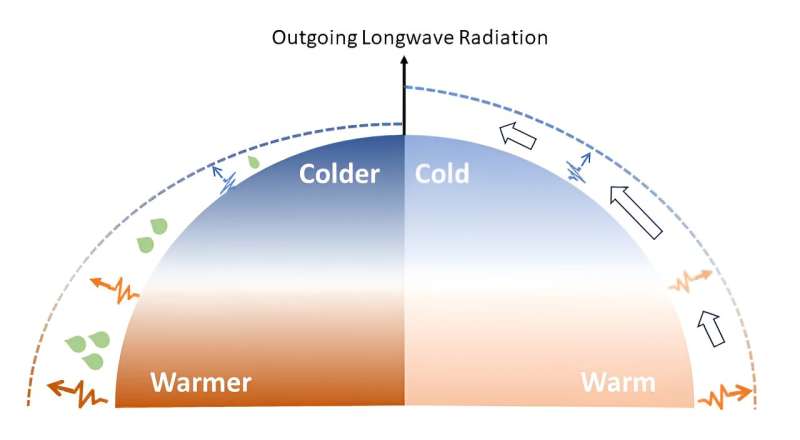Diagram depicting the two main processes for quasi-linear surface temperature and outgoing longwave radiation (OLR). Left: enhancement of meridional surface temperature gradient by the greenhouse effect of water vapor; Right: Re-routing part of OLR from warm places to cold places by poleward energy transport. Credit: Ming Cai and Xiaoming Hu
Curious about what drives Earth's climate sensitivity? A recent study in Advances in Atmospheric Sciences explores the complex links transforming the relationship between surface temperature and outgoing longwave radiation (OLR) from quartic to quasi-linear.
Led by Dr. Jie Sun from Florida State University, this research unravels hidden mechanisms shaping our planet's climate, providing fresh insights into why the temperature and OLR relation deviates from the quartic pattern stated by the Stefan-Boltzmann law.
What is the Stefan-Boltzmann law? Greenhouse gases in the atmosphere create a contrast between surface thermal emission, linked to the fourth power of surface temperature, and OLR.
Prof. Xiaoming Hu from Sun Yat-sen University, the corresponding author of the study, explained, "Vertical convective energy transport acts like an atmospheric mixer, swirling temperatures within a column. This allows the relation between surface temperature and OLR to still follow the quartic pattern by lowering the radiative emission layer."
The study uncovers how various factors influence surface temperature and OLR. The greenhouse effect of water vapor acts as a magnifier, amplifying temperature differences across the Earth's surface without altering the latitudinal variation of OLR. This suppresses the nonlinearity between OLR and surface temperature.
Poleward energy transport, on the other hand, functions as an equalizer, harmonizing temperature disparities across different regions of the globe. One of the by-products of this global heat redistribution is the re-routing of OLR from warm places to cold places, acting to reduce OLR differences across different regions. This, in turn, further suppresses the nonlinearity.
Prof. Ming Cai from Florida State University said, "Understanding these complex climate interactions is akin to decoding a puzzle. Each piece brings us closer to deciphering our planet's climate intricacies."
By illuminating these connections, scientists make significant strides in comprehending Earth's climate and how its intricate components orchestrate the overall climate sensitivity, namely not only energy output rate but also where the output takes place.
More information: Jie Sun et al, A Quasi-Linear Relationship between Planetary Outgoing Longwave Radiation and Surface Temperature in a Radiative-Convective-Transportive Climate Model of a Gray Atmosphere, Advances in Atmospheric Sciences (2023). DOI: 10.1007/s00376-023-2386-1
Journal information: Advances in Atmospheric Sciences
Provided by Chinese Academy of Sciences
























